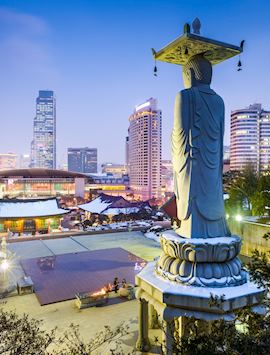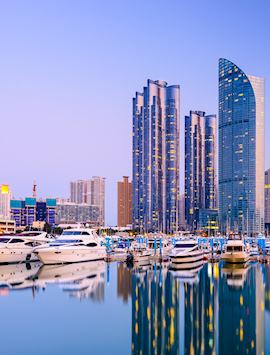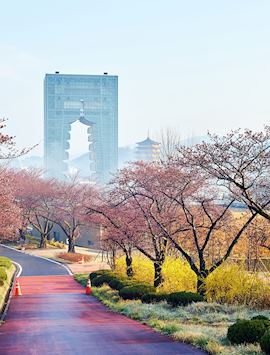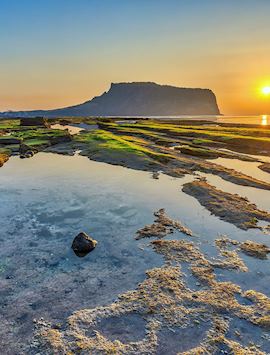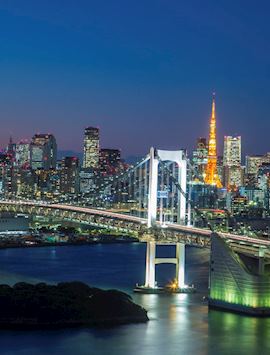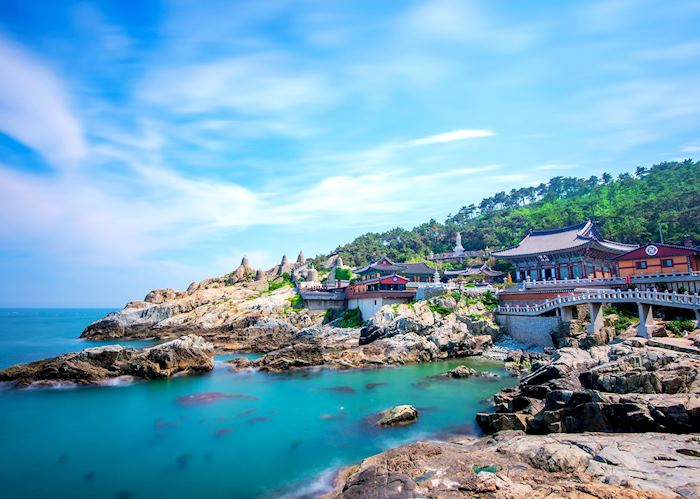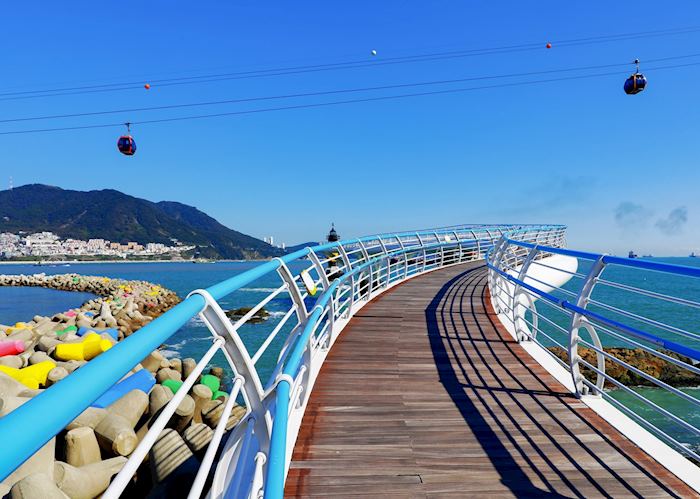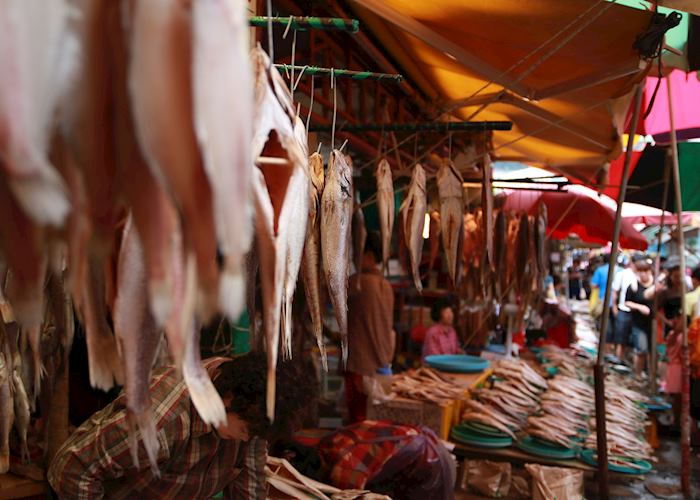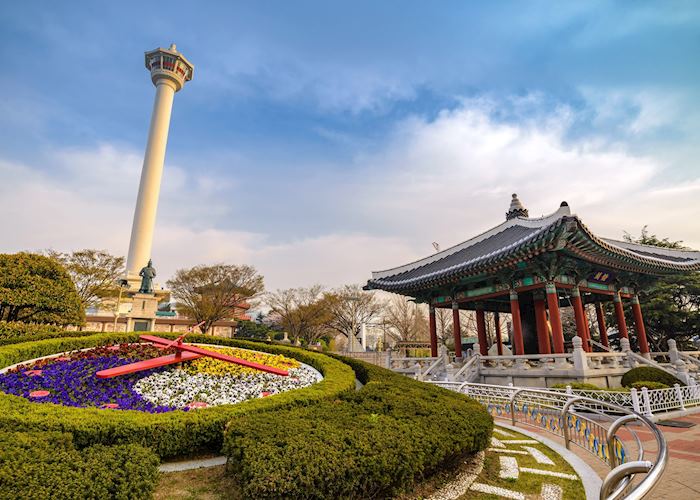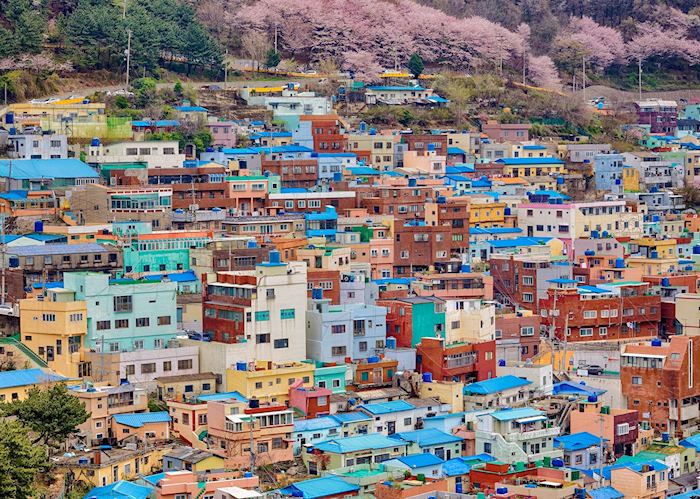Jump to:
An economic powerhouse and Korea’s second-largest city, Busan is by turns frenetic, charismatic and characterful. Korea’s primary port, it has a significantly different atmosphere to Seoul, with mountains cutting through the city streets, Korea’s largest and most popular beach, and a series of tempting hot springs and baths all over the city.
You can explore malls and markets for antiques and collectables, seek out tranquil temples, or visit historic districts that once offered shelter to fleeing refugees but have since been transformed into bohemian enclaves.
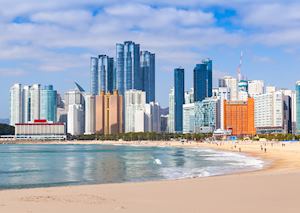 It’s also easy to leave the fast-paced city streets behind to stroll in Yongdusan Park on Dragon’s Head Mountain and climb Busan Tower for a panoramic view. Alternatively, relax on the beach, walk the rugged coastline with its pine forests and bluffs or take boat trips to explore its islands and coves.
It’s also easy to leave the fast-paced city streets behind to stroll in Yongdusan Park on Dragon’s Head Mountain and climb Busan Tower for a panoramic view. Alternatively, relax on the beach, walk the rugged coastline with its pine forests and bluffs or take boat trips to explore its islands and coves.
Busan traded with the Japanese for centuries before the Imjin War in the 16th century brought invasions and widespread destruction. Many of the city’s temples were destroyed at this time but later rebuilt in meticulous detail. You can visit Beomeosa Temple, to the north of the city, set on the slopes of Geumjeongsan Mountain. The original 7th-century temple was rebuilt in the 17th century and houses a three-level pagoda, pavilions, gates and hermitages surrounded by wisteria woodland.
By total contrast, the Jagalchi Fish Market is noisy, smelly and captivating in equal measure. It’s the largest fish market in Korea and offers an intriguing look at local life. The arrival of the day’s catch triggers an early morning scrum as locals haggle over everything from eel and squid to sea worms and baby octopus.
Wooden crates and carts, baskets and tanks line the ground floor, while upstairs, diners devour fish and seafood almost straight from the docks. Try some grilled tuna on the outdoor stalls, sashimi inside, or choose a fish and have it cooked upstairs.
Nearby, Gukje Market has been going since the 1950s, when war refugees began selling whatever goods they could get their hands on. Today, you’ll find homewares, electronics, eye-glasses, cosmetics, dried seaweed and ceramics. Each of the lanes is named after the goods sold there, making it relatively easy to navigate.
Also in Busan is Korea’s most popular beach, Haeundae, which stretches 2 km (1.2 miles) along the southern coast and attracts visitors from across the country, particularly in July and August. The area itself is one of the city’s liveliest, with lots of bars, restaurants, shops and markets and a host of five-star hotels, as well as some of the best street-food stalls in the city.
Busan was one of only two Korean cities to remain in UN control during the Korean War, and the United Nations Memorial Cemetery is a poignant reminder of the conflict. The suburb of Gamcheon tells a very different story however.
Once a ramshackle residential area that became a popular destination for fleeing refugees, its tiny houses are stacked like egg boxes on the steep foothills north of Busan. Today, it’s one of the most vibrant, bohemian places in the city. Groups of students and residents have painted their houses in bright shades and added street art and sculptures to the narrow lanes and winding stairways, attracting more artists, galleries and cafés. Now known as the Gamcheon Culture Village, you can explore the tangle of lanes and stairways, decorated with bright artwork and quirky street furniture.
 To get away from city’s bustle, visit Taejongdae Park, on the southern tip of Yeongdo Island. Here you can follow walking trails through pine forests and along sea cliffs to coastal bluffs and scenic lookouts. Take in views from the Taejongdae Observatory and Yeongdo Lighthouse, where you can also stop for an alfresco lunch of clams, mussels and sea cucumber.
To get away from city’s bustle, visit Taejongdae Park, on the southern tip of Yeongdo Island. Here you can follow walking trails through pine forests and along sea cliffs to coastal bluffs and scenic lookouts. Take in views from the Taejongdae Observatory and Yeongdo Lighthouse, where you can also stop for an alfresco lunch of clams, mussels and sea cucumber.
A more central destination to visit is Yongdusan Park, which offers views over the port and coastline from the Busan Tower, and the chance to see a traditional Korean bell.
Best time to visit Busan
From late-March to early-April, you can see cherry blossom in bloom, while October to November is best for autumnal foliage. May’s also a pleasant month, but from June to August heat and humidity peaks and rain is a constant risk. September is typhoon season, while cold winter temperatures keep visitor numbers low from December to mid-March.
who's been there
-
617-223-4521617-223-4901
- Make an inquiry
Suggested itineraries featuring Busan
Our itineraries will give you suggestions for what is possible when you travel in Busan, and they showcase routes we know work particularly well. Treat them as inspiration, because your trip will be created uniquely by one of our specialists.
Places near Busan
- Gyeongju 48 miles away
- Jeju island 192 miles away
- Seoul 203 miles away
Photos of Busan
Accommodation choices for Busan
We've selected a range of accommodation options for when you visit Busan. Our choices usually come recommended for their character, facilities and service or location. Our specialists always aim to suggest properties that match your preferences.
-
![King room]()
Park Hyatt Busan
Busan -
![Exterior]()
Lotte Hotel Busan
Busan
Ideas for experiencing Busan
Our specialists seek out authentic ways to get to know the places that could feature in your trip. These activities reflect some of the experiences they've most enjoyed while visiting Busan, and which use the best local guides.
-
Highlights of Busan tour ![Busan port]()
Highlights of Busan tour
Highlights of Busan tour
Korea’s second-largest city has an unusual, captivating history. Accompanied by a local guide who can explain the city’s character, culture and history, you’ll visit its most interesting sights and explore some of the country’s largest markets.
View details


